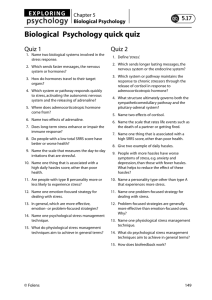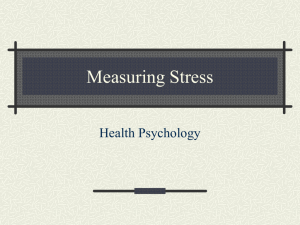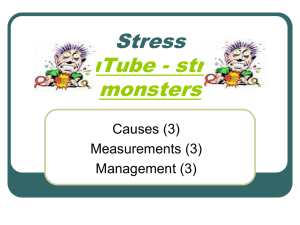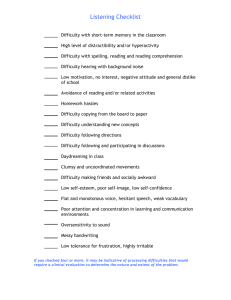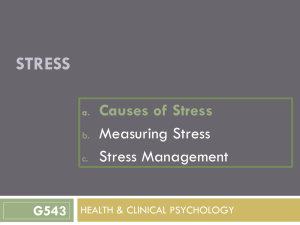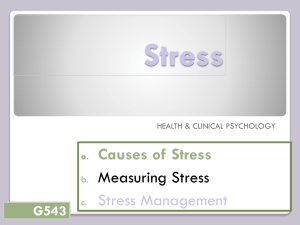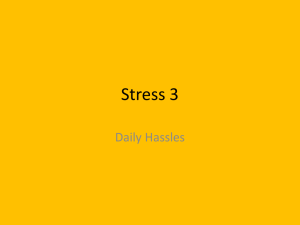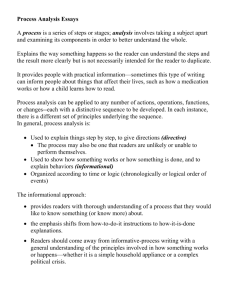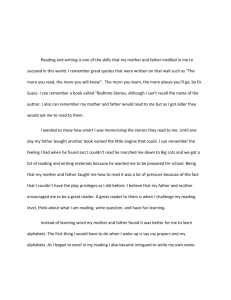Physiological Measures
advertisement
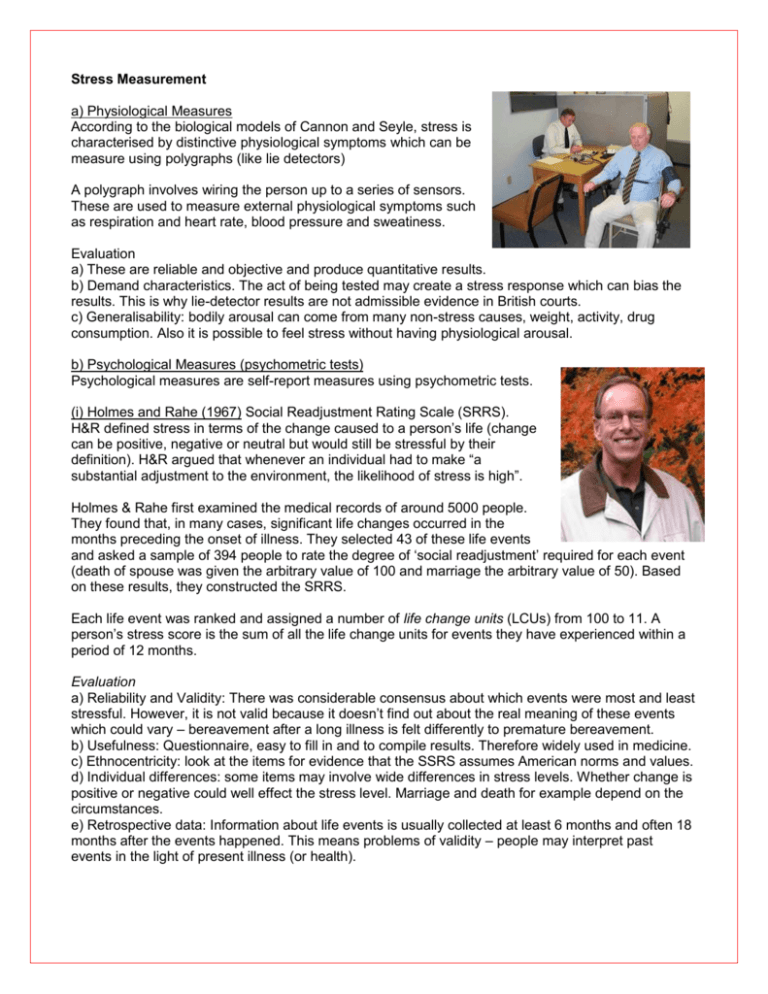
Stress Measurement a) Physiological Measures According to the biological models of Cannon and Seyle, stress is characterised by distinctive physiological symptoms which can be measure using polygraphs (like lie detectors) A polygraph involves wiring the person up to a series of sensors. These are used to measure external physiological symptoms such as respiration and heart rate, blood pressure and sweatiness. Evaluation a) These are reliable and objective and produce quantitative results. b) Demand characteristics. The act of being tested may create a stress response which can bias the results. This is why lie-detector results are not admissible evidence in British courts. c) Generalisability: bodily arousal can come from many non-stress causes, weight, activity, drug consumption. Also it is possible to feel stress without having physiological arousal. b) Psychological Measures (psychometric tests) Psychological measures are self-report measures using psychometric tests. (i) Holmes and Rahe (1967) Social Readjustment Rating Scale (SRRS). H&R defined stress in terms of the change caused to a person’s life (change can be positive, negative or neutral but would still be stressful by their definition). H&R argued that whenever an individual had to make “a substantial adjustment to the environment, the likelihood of stress is high”. Holmes & Rahe first examined the medical records of around 5000 people. They found that, in many cases, significant life changes occurred in the months preceding the onset of illness. They selected 43 of these life events and asked a sample of 394 people to rate the degree of ‘social readjustment’ required for each event (death of spouse was given the arbitrary value of 100 and marriage the arbitrary value of 50). Based on these results, they constructed the SRRS. Each life event was ranked and assigned a number of life change units (LCUs) from 100 to 11. A person’s stress score is the sum of all the life change units for events they have experienced within a period of 12 months. Evaluation a) Reliability and Validity: There was considerable consensus about which events were most and least stressful. However, it is not valid because it doesn’t find out about the real meaning of these events which could vary – bereavement after a long illness is felt differently to premature bereavement. b) Usefulness: Questionnaire, easy to fill in and to compile results. Therefore widely used in medicine. c) Ethnocentricity: look at the items for evidence that the SSRS assumes American norms and values. d) Individual differences: some items may involve wide differences in stress levels. Whether change is positive or negative could well effect the stress level. Marriage and death for example depend on the circumstances. e) Retrospective data: Information about life events is usually collected at least 6 months and often 18 months after the events happened. This means problems of validity – people may interpret past events in the light of present illness (or health). The Social Readjustment Rating Scale (SRRS) RANK 1 2 3 4 5 6 7 8 9 10 11 12 13 14 15 16 17 18 19 20 21 22 23 24 25 26 27 28 29 30 31 32 33 34 35 36 37 38 39 40 41 42 43 44 LIFE EVENT Death of spouse Divorce Marital separation Jail term Death of close family member Personal injury or illness Marriage Fired at work Marital reconciliation Retirement Change in health of family member Pregnancy Sex difficulties Gain of new family member Business readjustment Change in financial state Death of close friend Change to different line of work Change in number of arguments with spouse Mortgage or loan over $10, 000 Foreclosure of mortgage or loan Change in responsibilities at work Son or daughter leaving home Trouble with in-laws Outstanding personal achievement Wife begins or stops work Begin or end school Change in living conditions Revision of personal habits Trouble with boss Change in work hours or conditions Change in residence Chang in schools Change in recreation Change in church activities Change in social activities Mortgage or loan less than $10, 000 Change in sleeping habits Change in number of family get-togethers Change in eating habits Vacation Christmas Minor violations of the law : Health: Stress VALUE 100 73 65 63 63 53 50 47 45 45 44 40 39 39 39 38 37 36 35 31 30 29 29 29 28 26 26 25 24 23 20 20 20 19 19 18 17 16 15 15 13 12 11 7 (ii) Kanner et al, 1981: Daily Hassles & Uplifts An alternative self-report measure for stress was designed by Kanner. He argued that H&R focused on the big but rare events which are not central to people’s everyday experience. Instead he believed that the small but frequent ‘daily hassles’ were a more important source of stress, eg losing keys, oversleeping, having to write an essay etc On the other hand, certain day-to-day events can have positive effects on stress levels. So, in addition to hassles, Kanner's scale also takes into account uplifts - such as a compliment or a present. Key Study Kanner et al 1981 Aim: to see if daily hassles and uplifts scales are more accurate in predicting stress than the SSRS Method: Kanner devised a list of 117 hassles and 135 uplifts. Participants were asked to circle the events which they had experienced in the previous month and then rate each according to severity (for the hassles) and frequency (for the uplifts). Each participant was tested once a month for ten consecutive months using the two stress measures together with another two psychometric tests for psychological well-being. Sample 100 participants (52 women, 48 men; all white, well-educated and well-off) in Alameda County (San Francisco). Results The researchers found that the hassles scale tended to be a more accurate predictor of psychological problems than the SRRS. Uplifts had a significant effect on stress levels of women, but not men. The table below lists the ten most common daily hassles and uplifts 1 2 3 4 5 6 7 8 9 10 Daily Hassles Concerns about weight Health of a family member Rising price of common goods Home maintenance Too many things to do Misplacing or losing things Outside home maintenance Property, investment or taxes Crime Physical appearance 1 2 3 4 5 6 7 8 9 10 Daily Uplifts Relating well to spouse or partner Relating well to friends Completing a task Feeling healthy Getting enough sleep Eating out Meeting your responsibilities Visiting, phoning or writing to someone Spending time with the family Finding your home a pleasant environment Evaluation The daily hassles scale has most of the same problems as the SRRS. The link between hassles and psychological and physical disorders is correlational. For example, the increase in hassles preceding a cold may be due to feeling rundown as a result of the early stages of the illness. Because of this, situations which people would normally take in their stride are interpreted and experienced as hassles.
